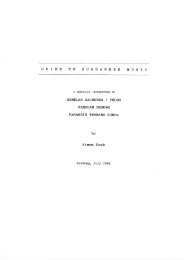Wet rice cultivation in Indonesia - Free EBooks Library
Wet rice cultivation in Indonesia - Free EBooks Library
Wet rice cultivation in Indonesia - Free EBooks Library
You also want an ePaper? Increase the reach of your titles
YUMPU automatically turns print PDFs into web optimized ePapers that Google loves.
<strong>Wet</strong> <strong>rice</strong> <strong>cultivation</strong> <strong>in</strong> <strong>Indonesia</strong> Appendix 11<br />
Appendix 11<br />
Summary of the <strong>in</strong>ternship report<br />
The <strong>in</strong>teraction between local authorities and the Kasepuhan<br />
In relation to the utilisation and management of traditional wet <strong>rice</strong> <strong>cultivation</strong><br />
In the southern area of National Park Gunung Halimun, West-Java, a traditional rural<br />
community called the Kasepuhan still practises traditional wet <strong>rice</strong> <strong>cultivation</strong>. This can be<br />
characterised by only one harvest per year, the utilisation of specific tools, and production<br />
for self-sufficiency only. However, the <strong>Indonesia</strong>n government has been ma<strong>in</strong>ta<strong>in</strong><strong>in</strong>g a<br />
strong modernisation policy <strong>in</strong> relation to wet <strong>rice</strong> <strong>cultivation</strong> dur<strong>in</strong>g the last decades.<br />
The report focuses on the question if this policy altered the traditional <strong>rice</strong> <strong>cultivation</strong><br />
of the Kasepuhan. If so, what aspects of the <strong>cultivation</strong> process have changed and how<br />
where these changes set <strong>in</strong> motion by the government? Is there a certa<strong>in</strong> pressure on the<br />
way <strong>in</strong> which the people of the Kasepuhan cultivate their fields, caused by local official<br />
authorities on the one hand, and the traditional authorities on the other hand?<br />
The highest traditional leader of the Kasepuhan is granted with an almost unlimited<br />
legitimacy with regard to his leadership and policy. The people of the Kasepuhan accept this<br />
leadership <strong>in</strong> the perception that their highest leader is chosen by their ancestors, and that<br />
his policy is <strong>in</strong>directly determ<strong>in</strong>ed by the same ancestors. For the survival of the traditional<br />
way of life of the Kasepuhan <strong>in</strong> general, and for the subsistence of him as the leader, it is of<br />
crucial importance that the people Kasepuhan cont<strong>in</strong>ue their traditional way of cultivat<strong>in</strong>g<br />
sawahs.<br />
The Agricultural Service Office, a local department of the M<strong>in</strong>istry of Agriculture, is<br />
still practic<strong>in</strong>g their policy of chang<strong>in</strong>g the traditional <strong>cultivation</strong> of self-sufficiency towards<br />
<strong>rice</strong> as a commodity product. In the era of Suharto this happened <strong>in</strong> a very structured and<br />
rigorous manner. All aspects of traditional sawah <strong>cultivation</strong> were to be changed. S<strong>in</strong>ce the<br />
fall of the regime, decentralisation is commonly used as a tool to transfer responsibility from<br />
higher levels of government to lower levels. The Service Office still tries to <strong>in</strong>fluence the<br />
traditional methods and techniques used by the Kasepuhan. As a consequence of<br />
decentralisation, the Kasepuhan are confronted more often with the Service Office. The<br />
Service Office tries to make clear to the Kasepuhan and their leaders what the advantages<br />
are of switch<strong>in</strong>g to two or even three harvests per year. This is specifically done by attempts<br />
to <strong>in</strong>troduce high-yield<strong>in</strong>g <strong>rice</strong> varieties and the <strong>in</strong>troduction of chemical fertilisers.<br />
Switch<strong>in</strong>g to a commodity system of <strong>rice</strong> <strong>cultivation</strong> by Kasepuhan farmers does happen.<br />
But it implies a permanent renouncement of all Kasepuhan traditions. In this case a farmer<br />
is not allowed to live with<strong>in</strong> the territory of the Kasepuhan. The surplus of the harvest can be<br />
sold though, which might imply the generat<strong>in</strong>g of some money and a better way of life <strong>in</strong> a<br />
f<strong>in</strong>ancial sense. On the other hand, if a harvest fails, there is no support of the traditional<br />
leader or the Kasepuhan community. Moreover, leav<strong>in</strong>g the Kasepuhan community also<br />
means liv<strong>in</strong>g <strong>in</strong> the lower areas of the mounta<strong>in</strong>s, and thus less access to irrigation water.<br />
With<strong>in</strong> the community, there is far more cooperation between Kasepuhan farmers<br />
consider<strong>in</strong>g the <strong>cultivation</strong> of sawahs.<br />
It seems right to conclude that the people of the Kasepuhan are squeezed between their<br />
tradition and adat on one side, and the attractiveness of more f<strong>in</strong>ancial welfare on the other<br />
side. This might be <strong>in</strong>fluenced by the effects of decentralisation of governmental<br />
departments l<strong>in</strong>ked with the M<strong>in</strong>istry of Agriculture.<br />
Official <strong>in</strong>stitutions such as the Agricultural Service Office are possibly focused too much on<br />
the economical perspective – although with well-meant <strong>in</strong>tentions – and too less on the<br />
97








